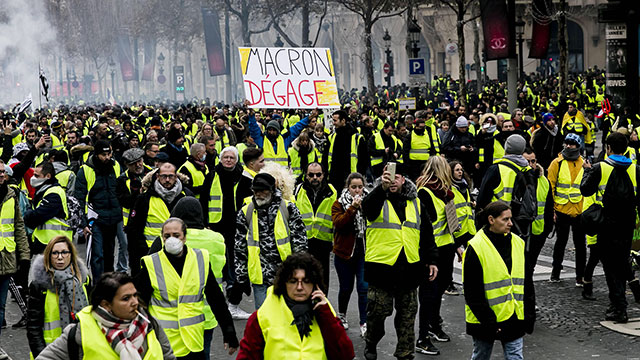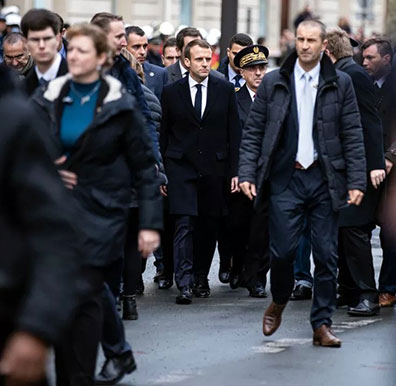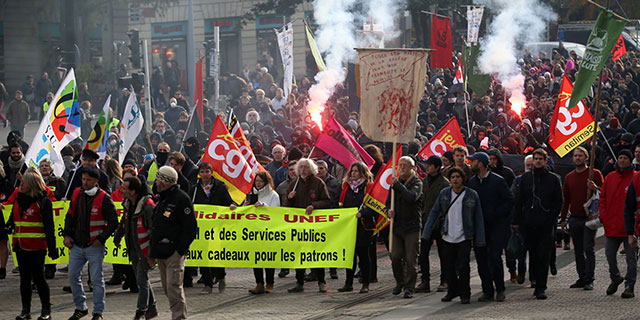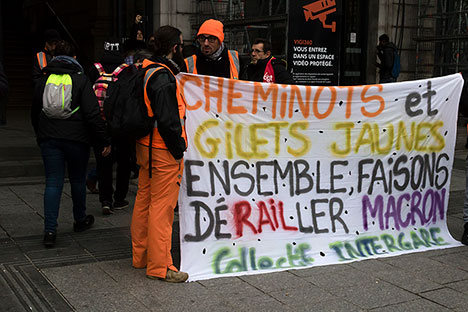
June 2019
France: “Yellow Vest” Revolt and
the Struggle for Socialist Revolution

Yellow Vest demonstration in Paris, November 2018. Sign says: “Macron, get lost!” (Photo: Deutsche Welle)
- For Workers Action Against Police Repression!
- Mobilize the Power of the Working Class to Defeat the Capitalist Austerity Drive!
- Build a Multi-Ethnic Workers Party on the Program of Lenin and Trotsky
The following article is translated from L’Internationaliste No. 10, French-language publication of the League for the Fourth International.
It is now more than six months since the first demonstrations of the “Gilets jaunes” (Yellow Vests) in France. Thousands of people are still demonstrating, although the bourgeois media have been waiting – with ill-disguised impatience – ever since the movement began for it to ebb and then die. Ferocious repression has reduced the demonstrations to a hard core, and an unrelenting media propaganda campaign has eroded initial high public support, but the guerrilla warfare is far from ended. The cop attacks are the most massive and brutal since May 1968. Yet bourgeois media around the world – so quick to denounce “violence” against coup-plotting racist bourgeois in Venezuela – cover up the police terror in France.
The social polarization was thrown into sharp focus by the responses to the fire that damaged the Parisian cathedral of Notre Dame in April. While French president Macron used this as one more pretext to appeal for national unity, many yellow vests were rightly enraged that French firms, many state-subsidized, could nonchalantly offer hundreds of millions of euros for repairs as a charitable act while social services are cut to the bone. Since taking office in May 2017, Macron has introduced new anti-worker labor laws, begun the privatization of the SNCF state rail system, slashed thousands of jobs in the public sector and created new barriers to access to the universities. He canceled the wealth tax while increasing taxes on pensions and cutting rent subsidies.
The increased taxes on fuel, which especially hit working people, was the drop that made the glass overflow, setting off the Yellow Vest revolt. Across Europe, social unrest following the financial crash in 2008 has taken the form of a variety of populist movements and parties. These have mobilized large sections of the petty bourgeoisie as well as workers, youth and others hard-hit by the global economic crisis. Some have had a rightist-nationalist character, targeting immigrants and shading into fascistic parties like the Lega in Italy and outright fascists like the National Rally (formerly National Front) in France. Others have tended to the left, such as SYRIZA in Greece, or Podemos in Spain. But the vicious austerity has continued as none have posed a class opposition to the capitalist system.
The Yellow Vests are another of these populist movements which have come and gone in recent years. Rather than a structured political formation, in France it has been more of a loose “mouvance,” or milieu, reflecting the fact that it embraces both leftists and rightists, and many who fled the mainstream capitalist parties. Such multi-class movements – whether of the “left,” right or center – are bourgeois in character, and thus cannot lead a revolutionary struggle to bring down capitalism. The fact that they have channeled popular protest against inequality and austerity is history’s punishment for the lack of a revolutionary leadership of the working class. To go forward it is necessary to mobilize the proletariat to overturn the class axis of the struggle.
The government is certainly doing its best to prepare the terrain. The police-state measures culminated in tear-gas and water-cannon attacks on trade-union contingents as well as yellow vests and others in Paris on May Day. But the lead-up to the sudden and unexpected emergence of the Yellow Vests was a series of defeats of the organized workers movement centrally due to the fact that the trade-union bureaucracies continue to function as the labor lieutenants of capital in sabotaging struggles. While the CFDT (Confédération Française Démocratique du Travail) and Force Ouvrière “dialogue” with Macron over his anti-labor “reforms,” the reputedly more militant CGT (Confédération Générale du Travail, once linked to the Communist Party) only offers token one-day mobilizations. The so-called “far left” (the NPA – New Anticapitalist Party) and L.O. (Lutte Ouvrière [Worker Struggle]) in turn acts as the “left” flank of these bureaucracies.
The situation cries out for a workers leadership that goes beyond simple trade-unionism, on a program to unite the entire working class and rally the pensioners, the youth, the unemployed and immigrants in hard class struggle. The Yellow Vests began as a movement of the provinces against the glittering élite of the capital. But while disrupting traffic and some commercial transport, they lack the social power of the organized working class. To bring down Macron, the investment banker who fancies himself a pint-size Napoléon (or even the supreme god Jupiter), it is necessary to join together with the besieged working-class and immigrant suburbs, headed up by the “heavy battalions” of industrial workers and led by a multiethnic revolutionary workers party. To that end, a Leninist-Trotskyist vanguard would put forward a series of transitional demands leading to a workers government.
Stop the Repression Against the Yellow Vests!
Since the beginning of the Yellow Vests protests in November 2018, the government of Emmanuel Macron has responded with massive repression on a scale not seen in decades. Over the course of six months of demonstrations, 12,107 demonstrators were picked up for questioning, of whom 10,718 were held in police custody, i.e., jailed (Canal+, 15 May). Some 1,500 were detained on a single day (December 8), an all-time record, far surpassing the numbers of those arrested in the police-state round-ups during the 2017 G20 summit in Hamburg.
In addition, according to revelations in the Canard Enchaîné (17 and 24 April), Paris hospitals were repeatedly ordered to turn over the names of those injured in the police attacks.
More than 2,000 yellow vests have been tried, found guilty and sentenced, the vast majority in immediate trials. Of those, around 800 were sentenced to prison time. Meanwhile, thousands have been injured in the vicious police onslaught, including more than 280 who received head injuries, mostly from rubber bullets and grenades, while two dozen were hit in the eye, losing their sight, and five had their hands severed. Naturally, no police have been charged.
This orgy of cop violence and repression and is a threat to all, and to fundamental democratic rights. We demand that all charges against Yellow Vests protesters be dropped, that all those arrested be released from jail or police custody, and that all convictions be wiped off the books! ■
A Heterogeneous Populist Movement
Adopting as their symbol the yellow warning jacket that is mandatory for all French motorists, some 300,000 people came out on November 17 and set up more than 2,000 road blocks in what was initially a rebellion against the gasoline tax hike. It soon became a diffuse revolt spurred on by the insufferable arrogance of French President Emmanuel Macron. In December, Macron announced that the fuel tax increase would be postponed, along with a few other trivial concessions, and he would begin a “listening tour” through the country. After some months of a staged monologue, in April Macron announced the next round of capitalist attacks, barely camouflaged, saying his reforms “should be preserved, pursued and intensified".
The Yellow Vest movement has vented the widespread anger and outrage of millions of people against rising prices and taxes. The “eco-tax” which drove up gasoline prices meant a new burden for wide sections of the population. As in recent protests against the 2017 gasolinazo in Mexico, the May 2018 truckers revolt in Brazil and the near-insurrection in Haiti in July, the tax hikes aimed at cutting fuel consumption were ordered by international financial agencies. Macron’s claims to be concerned with the environment are downright insulting. In fact, given the deliberate running down of public transport, the shrinking number of government offices, social services, hospitals, schools, shops, etc., people living outside the central cities need their cars more than ever.
This was indeed an explosion of la France profonde, the “deep France” of the provinces. The provinces have been written off as nests of reaction since the days of the Jacobins and the Paris Commune. Today, they are where the fascist RN gets its highest electoral scores. Like every cliché, this has some elements of truth, but only some. A study of some of the first yellow vests protestors published in Le Monde (11 December 2018) showed that, sociologically, this is a working-class and lower-middle-class movement. There were higher proportions of white-collar employees and self-employed, but many barely make the minimum wage. The median age was 45 years, slightly older than the French average, reflecting the fact that a quarter were retirees.
 The self-described
“Jupiterian” president on an inspection of tour of Paris
accompanied by his cops, 2 December 2018.
The self-described
“Jupiterian” president on an inspection of tour of Paris
accompanied by his cops, 2 December 2018. (Photo: Etienne Laurent/EPA)
This is thus not a reedition of the Poujadist movement of the 1950, a reactionary movement which represented the declining traditional middle class, mainly shopkeepers. But it is also not the organized working class: 64% said that trade unions had no place in the movement. One-third said they were “neither left nor right” (often a reactionary line) and for almost half (47%), this was the first political activity.
From the beginning, the Yellow Vests thus banned not only political parties, but even any form of concrete collective decision-making and delegating authority. They did not want any “spokesmen” (or women), although the bourgeois media ended up singling out a few individuals. One the one hand, there were truck drivers Eric Drouet and Maxime Nicolle, suspected of fascist sympathies. And on the other, the black Caribbean French woman, Priscillia Ludosky. But Nicolle and Ludosky made a point of demonstrating together in Paris and then at Bourges in January. Seeking consensus, the movement simply piled up demands, no matter how contradictory. In the end, political polarization was averted by avoiding actual political debate and decision-making.
A list of 42 demands emerged at a national meeting in Commercy in December. These included reimposing the tax on the wealthy, raising the minimum wage, jobs for the unemployed and better pensions, lower class sizes, full retirement at 60, or at 55 for those engaged in heavy physical labor, stopping the closures of local train lines, post offices and schools, etc. In short, a list of all good things which could have been compiled via opinion poll. Many could even be supported by an agile fascist demagogue. Demands like higher taxes on McDonalds and Google, and forbidding the sale of dams and airports, could have a French nationalist slant. Some called for better treatment of refugees, but also for rapid expulsion of those whose cases are rejected.
There was above all a great deal of sentiment for deciding political matters via referendums. This is a pseudo-democratic, and ultimately anti-democratic, procedure in which the bourgeois state manipulates the population by offering it carefully selected and limited alternatives. Such plebiscitary rule was favored by Napoleon III and De Gaulle. But within the movement itself there was and is no mechanism for deciding which views have a majority, or for eventually repudiating any of them, or of deciding strategy for that matter. The movement has remained splintered into hundreds of local groups, and attempts to organize a slate for the European Parliament elections collapsed.
While their anger is directed against bankers and capitalist politicians, the protesters’ consciousness was by no means revolutionary and not even implicitly “anti-capitalist,” as some on the left would have it. In this respect, it resembles the Spanish Indignados of 2011 and the Nuit Debout (“Up All Night”) movement which occupied public squares, mainly in Paris, in 2016. These movements had a large number of fairly privileged middle-class youth (even if their studies had left them jobless), with a limited number of young workers and still less of immigrant workers. The yellow vests, on the other hand, are lower-middle-class or working-class and less articulate, and thus far less attractive to any journalists who are not simply regurgitating the government line about the Yellow Vest being mere thugs.
Like the Yellow Vests, Nuit Debout also did not exclude fascists or reactionaries and had a lot of talk about rewriting the constitution. It was however much more closely associated with the “La France Insoumise” (France Unbowed – LFI) movement which issued from the social-democratic Parti de Gauche as a personal vehicle for Jean-Luc Mélenchon on an explicitly nationalist/populist basis. And what with waving the French tricolor, singing the national anthem (the Marseillaise), and making anti-immigrant remarks, it’s not surprising that the yellow vests have never really taken root in Paris, other major cities and the banlieues, having nothing to offer the immigrant population.
Lessons of the Defeat in Rail

Union demonstration in Paris on 22 March 2018 during the rail workers strike. Rather than calling a general mobilization, the labor bureaucrats let the revolving strikes drag on. The result: one more defeat. (Photo: Reuters)
In 2016, the “socialist” government of French president François Hollande and his prime minister Manuel Valls came up with the El Khomri law, named after its minister of labor, which made it easier for the bosses to lay off workers and reduce overtime and severance payments. Hollande rammed through the law, preventing a vote in parliament, even though it meant the self-destruction of the Socialist Party (in the service of capital). Yet it met stiff resistance from the working class. Strikes in a number of sectors, such as the ports, were effective, and pickets quite successfully blocked gas refineries and depots. Although Philippe Martinez, the head of the CGT, was portrayed as an unreasonable intransigent, what he actually said was, “As long as the government refuses to discuss, the mobilization will continue” (Le Figaro, 25 May 2016).
But what was there to discuss? A genuine struggle – i.e. a real and not a token general strike – would have meant taking control out of the hands of the venal bureaucrats, going beyond the local initiatives in individual workplaces to create organized forms embodying the struggle: elected strike committees to unite all the unionists, now split into different unions, as well as non-union workers, mass picket lines to spread the strike and defend the strikers; and national coordinating committees, linking Paris with mobilizations in provincial cities.
The El Khomri law was only a first step for the French bourgeoisie. Two years later, as one of his first acts, Macron went after the rail workers. In Le Monde (27 February 2018), one pundit advised him that dismantling the SNCF should “be presented as a battle… a heroic combat against the trade-union hydra,” as British prime minister Thatcher did against the miners union in the ’80s. Macron’s prime minister Édouard Philippe stressed his “determination,” another advisor commented, “It’s not 1995 anymore.” He was referring to the wave of public sector strikes that December which foiled government attempts to cut pensions.
The comparison with the British miners, who were finally quelled by wiping out the entire coal mining industry, underlines the key role played by rail workers in France for decades. In the 1986-87 rail strikes, with the trade union bureaucrats, including the CGT, widely discredited, coordinations (strike coordinating committees) sprung up in key rail hubs, such as Rouen. Many members of the “far left” played an active role then in uniting the struggle, going around the labor federation bureaucrats. But by 1995, such committees hardly existed, and the erstwhile leftists active in them were being assimilated into the union bureaucracies. In the 2000s, despite isolated attempts to revive them in some Paris terminals, these mass anti-bureaucratic coordinations were a distant memory.
Confronted with Macron’s plans as early as February 2018, the bureaucrats dithered, wasting time with endless “negotiations” although the government had already laid down its draft privatization law, and they scheduled a referendum in May. In addition to the usual impotent “days of action,” the bureaucrats finally settled on the losing tactic of “two out of five,” i.e., rotating two-day strikes followed by three days of work. These dragged on, demobilizing the railway workers, angering commuters and ensuring that there would be no junction with the students protesting Macron’s social selection schemes for higher education. Nor would there be common struggle with other public employees called out on their own “days of action” which occasionally overlapped with those of the railway workers.
Eventually, the trade union federation Solidaires (SUD), with support from the NPA, and LO supporters in the CGT began agitating for “renewable” strikes at each site; on at least one occasion the CGT tops called the cops against attempts to organize such a strike. But while more militant, this tactic evaded the need for the wider mobilization needed in a class confrontation of this magnitude, as well as the need for actual strike committees across the different union federations and an alternative leadership. Once again, the government plan was rammed through.
Today short-term labor contracts of less than a month duration outnumber unlimited contracts by 4.5 million to 1 million. Only half of those “disposable” workers on short-term contracts are even eligible for unemployment benefits. The official unemployment is over 9%, and the median monthly take-home pay (after taxes) is €1,700, a little over US20,000 a year. The government now threatens to lay off 120,000 public employees, because it believes it has now broken the back of trade-union resistance. But the fight is not over.
Missed Rendezvous
 The Interstation Collective
in Paris, le 8 décembre. “Train workers and Yellow Vests
together can derail Macron." Despite the disgusting
declaration of the union tops, echoing Macron’s appeal to
denounce “violence,” militant rank-and-file workers joined the
demonstrations.
The Interstation Collective
in Paris, le 8 décembre. “Train workers and Yellow Vests
together can derail Macron." Despite the disgusting
declaration of the union tops, echoing Macron’s appeal to
denounce “violence,” militant rank-and-file workers joined the
demonstrations. (Photo: Jacques Billaudel / Flickr)
Last November 17, CGT general secretary Martinez reacted to the Yellow Vest movement by declaring that it was “impossible to imagine the CGT marching together with the National Front,” further accusing it of being merely an anti-tax mobilization manipulated by the bosses. But if Martinez really believed this to be a movement dominated by the fascists, he should have proposed active opposition, rather than simply washing its hands of the matter. In point of fact, oil refinery workers went on a national strike on November 22 in annual wage negotiations. So in the Bouches-du-Rhône department, there were strikers at a Total refinery standing on the other side of the road from the yellow vests – a perfect opportunity for fraternization. The CGT bureaucracy hastened to settle the contract.
On December 5, Macron demanded that “political forces, trade-union forces and employers launch a clear and explicit call for calm and respect for the republican framework.” The CGT, CFDT, FO, FSU (one of the teachers federations) and several other trade union federations met to draw up a communique condemning “all forms of violence in the expression of demands” and congratulated the government on “opening the door to dialogue.” As a concrete manifestation of this betrayal, on December 7, after a meeting with the Transport Minister, the CGT and FO canceled the unlimited strike of truck drivers which was supposed to start three days later.
Finally, on February 5, after a certain amount of fraternization on the ground and pressure from the ranks, the CGT tops agreed to call a one-day general strike and to joint demonstrations with the yellow vests (many of whom, however, due to their precarious financial situation, only demonstrate on Saturdays). While the demonstrations were large enough, the strike itself was poorly followed: it was too little, too late, and not repeated. As Trotsky wrote of this tactic:
“The general strike is, by its very essence, a revolutionary means of struggle. In a general strike the proletariat assembles itself as a class against its class enemy. The use of the general strike is absolutely incompatible with the politics of the Popular Front which signifies alliance with the bourgeoisie, that is to say, the submission of the proletariat to the bourgeoisie. The miserable bureaucrats of the Socialist and Communist parties as well as of the trade unions consider the proletariat as a simple auxiliary instrument in their combinations behind the scenes with the bourgeoisie. They propose that the workers pay for a simple demonstration with sacrifices which cannot have any meaning in the workers’ eyes unless it is a question of a decisive struggle. As if the masses of millions of workers could make turns to the right and to the left at will, according to parliamentary combinations!”
–L.D. Trotsky, “The Decisive Hour in France” (December 1938)
While the trade unions (after a half-hearted struggle) have been repeatedly defeated, class struggle in France has never depended on the strength of trade union organization alone. As Macron promises new tax gifts to his base in the upper middle class, there will be yet more cuts in public services. Meanwhile, despite huge subsidies, companies like General Electric are laying off hundreds more workers.
Against this capitalist offensive, broad workers counter-offensive is called for. The fact that important parts of the petty bourgeoisie have mobilized against Macron's brutal measures, and that they are resisting repression, is extremely positive, but they have neither the social power nor the coherent class interest to prevail. Militant workers must take up the struggle to oust the bureaucrats and repudiate their defeatist class-collaborationist policies. By reaching out to the Yellow Vests, a revolutionary class-struggle leadership could win many of them to the revolutionary struggle.
A real strategy to confront this capitalist war on working people would involve striking key industries to demand that temporary contracts be converted into full-time positions; to shorten the workweek with no loss in pay, dividing up the available work to provide jobs for the unemployed; to index wages against inflation; to occupy the banks, opening their books for inspection by workers commissions to determine where the money has gone; and to impose workers control on refineries and rail hubs. In the context of such a program for mobilizing working-class power on the road to socialist revolution, the call for a general strike, an appeal directed both to the unions and rank-and-file workers as in May 1968 in France, is indeed necessary.
But that would sharply pose the question of which class rules, of “who is the master of the house,” as Trotsky put it in the 1930s. That underscores the vital need to cohere the nucleus of a revolutionary workers party, a Trotskyist party to lead the struggle for international socialist revolution. ■
